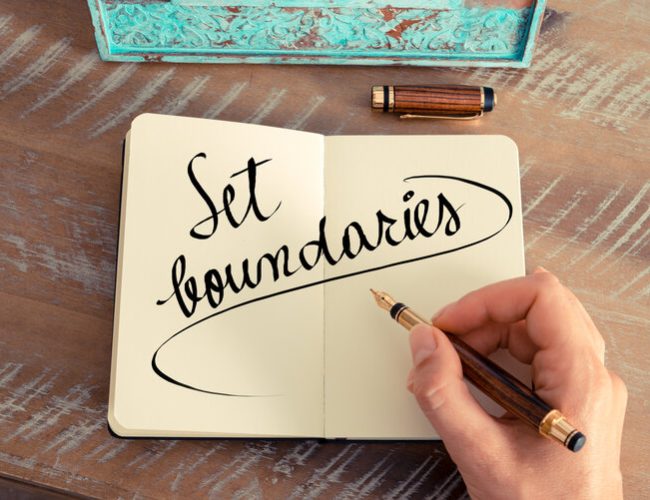GET TO KNOW YOUR OWN PERSONAL AND EMOTIONAL SPACE

So much of the work I do with people is exploring their boundaries. Believe it or not many people are not clear about their boundaries. If you haven’t done a good evaluation of your beliefs and your “shoulds”, you may not have clear and defined boundaries.
Often, What happens in sessions is people talking about something or someone they are struggling with. Together we embark on a journey only to find that a boundary needs to be set or a boundary needs to be seen.
Let’s define boundaries, this word has a few definitions and uses in our culture. Boundaries can be separators, they define the land masses of countries, towns, villages, and cities. These boundaries help us to know where one country ends and the other begins. These seem so clear and defined.
However in personal relationships, boundaries are often not clearly as defined. We can sometimes lose sight of where one person ends and the other begins. The word “boundary” can be a bit misleading in relationships. It conveys the idea of keeping yourself separate. However, personal boundaries are actually connecting points, they provide healthy rules for navigating all of our relationships.
The challenge with personal boundaries is they are often not defined because they can be invisible until we make them visible.
Many people are not aware and this leads to a lack of ability to read another’s behaviour and the boundary gets missed. In personal relationships we have to become skillful at communicating our boundaries, or both people will be sitting in a discomfort, conflict and unable to communicate.

Our boundaries are connectors in many ways. Lets begin the exploration:
What are your rights?
It is important in setting boundaries to identify your basic human rights. Here are a few below. You can create a list of your own rights as they can vary based on our experiences.
I have a right to say no, without explaining it to you.
I have a right to be treated with respect.
I have a right to make my needs important.
I have a right to ask for what I need.
I have a right to challenge the expectations of others.
Once you identify your rights, you have to believe in them. If you do, you’ll find honouring them easier. When you honour your own rights, you’ll stop spending energy pacifying or pleasing others who dishonour them.
What does your wisdom tell you?
Your gut feelings, and instincts can help you determine when someone is violating your boundaries or when you need to set one.
Use mindful awareness as your tool, “Check in with your body, what it is doing? Check your (heart rate, are you sweating, is there tightness in you chest, stomach, throat). Often your body is trying to tell you where the boundary should be drawn. Our body is a fantastic communicator if we are listening.
Maybe you clench your jaw when your wife asks you to take out the garbage 3 times in an evening. Or your right leg starts to bounce when your relatives ask about your dating life. Or your stomach starts to tighten when your co-worker steps into your personal space.
These are all indicators of places where boundaries or limits need to be set.
What are your values?
Your boundaries also relate to your moral and beliefs. Write down 10 values that are really important to you, now circle 5 of those things that are super important on the list, now down to 3 things are non negotiable.
Sit for a moment and ponder on how often those three are challenged, tread upon, or poked in a way that makes you feel uncomfortable. The discomfort is a communication that you need to set a boundary.

Boundaries create safety in our relationships……..
Even though personal boundaries can be challenging to navigate, setting and communicating them is essential for our health, well-being, and even our safety. We all have limits and communicating them is important.
It begins with being assertive. Assertiveness is based on mutual respect, it is an effective and diplomatic communication style. Being assertive shows that you respect yourself because you are willing to stand up for your interests and express your thoughts and feelings. It also demonstrates that you’re aware of others rights.
In Gestalt we use what is called “The Language of Responsibility” meaning “The ability to respond……”
Here are some examples of “response able” language that allows us to assert ourselves.
Using “I” statements instead of “you”, “we” or “they” when communicating what you need.
Begin with
I feel ____ when _____ because ____________________________.
What I need is ______________________________________________.
This is a clear communication of what you are feeling and what you need.
Changing “I can’t” to “I won’t”
When we use the word can’t in our vocabulary we are communicating an inability. We need to ask ourselves if “can’t” is actually true. Is there something stopping us, often it is fear. However, fear doesn’t mean we can’t do something, it means we are scared to do it. Taking responsibility means that we are making a choice, so instead of saying to someone “I can’t come tonight, I have to work early in the morning”, You could say something like, “I won’t be coming tonight, I need to get some rest, I have a early day”
Replace “But” with “And”
When we use the word but we are often caught in a discounting process. The word “but” has the ability to remove the previous statement. How often do you hear, “I don’t mean to be racist but………..” then the next words out of someone’s mouth are filled with racism. “I don’t mean to be hard on you but……..then the next words are filled with hard.
If you replace the word but with and you are owning what is said. I don’t mean to be hard on you AND I need to give you some feedback. I don’t mean to be racist AND I know that I am still working on how I am conditioned. The word AND creates two truths vs discounting one and or minimizing the impact you are about to have.
If you take the word but out of your vocabulary you will see a big difference in how you assert yourself into the world. You can feel the difference. Try it on.
“A frequent source of minimization is related to the use of the conjunction ‘but’… [which] is all too often introduced to disqualify a statement or take away some of its weight or validity.”— Dr. Claudio Naranjo
Use the word “no” without explanation. You don’t have to explain to anyone what your “no” is about.
Even though it can be daunting to say, “No” is a complete sentence.
We might be hesitant to say no without offering more info, but it’s not necessary, says Steven Reigns, a marriage and family therapist. “Sometimes assertiveness isn’t needed for boundary setting as much as personal tolerance for being uncomfortable.”
You can say no without an explanation, it is not you job to engage in the emotional labor for the person you’re saying it to. If someone asks you to dance, you can absolutely just say no. If a co-worker asks you to cover their shift, you can also say no, without offering any explanation. We seem to think that we have to explain ourselves to others. It is not necessary, what is necessary is to be willing to sit in the discomfort for a few moments.
There is a space between us, a place where we meet, a place where we differentiate between self and other.
The place where we make “contact” , where “I”, “you”, and “it” exists. In Gestalt Therapy, it is called the Boundary . That space is one of my favourite places to be.
It can also be a hard place to be. This space is where we make contact. We all come to that place in different ways.
